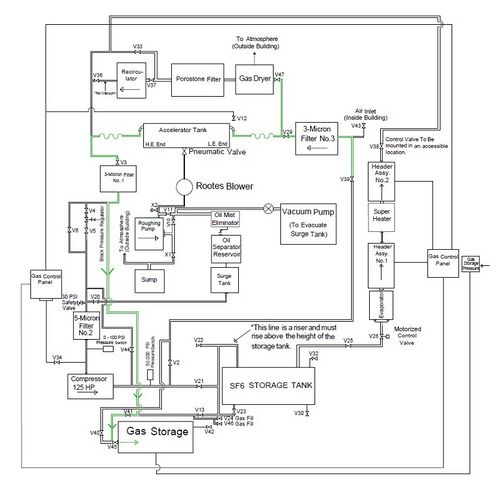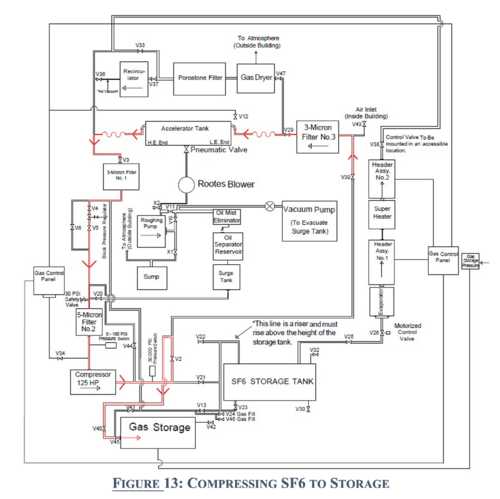SF6 Gas Handling System
NEED PROOF READING
Worthington Compressor
The Worthington compressor was installed in the early ’70s. It is a two stage oiless compressor with teflon piston rings and metallic reed valve assemblies. In 1995 the Dresser Rand was the current spare parts supplier (tel.1-800-634-5565). The compressor model no. is 12 1/2 X 5 X 13 HB B-2 and the serial no. is L89186. The compressor is driven by a 125 HP 3-phase motor coupled by belt and pulley. The internal connecting rod and crank do require lubrication and the recommended lubricant is ISO-VG-150; AGMA Grade 4.
The compressor is cooled with well water which is circulated through the water jacket surrounding the compressor cylinders and the heat exchanger. If the well water supply should fail the supply automatically changes over to the city water supply. The discharge from the compressor is sent to the dump well unless a valve change is made to route the water to the storm drain. The two labeled valves in the Gas Handling Room near the compressor need to be changed to allow the rerouting. After conditions return to normal and the well supply becomes available again, changes should be made to reroute the well water from dumping down the storm drain; the aforementioned valves will need to be put back in the original state. The switch from city water to well water supply is again automatic.
Emergency Valve Closures
If during a gas transfer the compressor should stop, a seal fail or some type of major leak of SF6start, it is important to safeguard the gas inventory. Also, at any time should a SF6 loss due to a failure on the Tandem pressure vessel or the storage tank and any of the directly attached valves occur a transfer of the SF6 inventory is suggested immediately. This, however, should not take precedent over safety as large quantities of SF6 can displace life sustaining air. Depending on where one is in the gas transfer the compressor may or may not be running; the response depends on whether the compressor is running.
Below are the responses to three sets of circumstances that may confront the operator; some valves may or may not already be closed. The valves affected in the Gas Handling Rm. are shaded red in the preceding room layout (figure 5). After the crisis has passed and the transfer piping schematic (figure 11) is consulted a more sensible arrangement of valves may be preferred.
Compressor is Off: Large Leak Detected
Compressor Has Failed During Gas Transfer: No Leak Detected
Compressor Is On: Large Leak Detected
Equalizing the SF6 Gas to the Outside Storage Vessel
Time: ∼ 25 minutes. Change in Pressure: 80 to 50 lbs/in2.
Ensure these valves are closed before beginning the gas transfer. Refer to the locator map (figure 5) for their approximate location: 38, 39, 43, 47, 35, 36, 4, 6, 13, 46, 40
- In the Control Room, turn off the power to the Terminal Potential Stabilizer panel and withdraw the Corona Probe.
- In the Tandem Vault, open the H.E. Tandem gas valve at the bottom of the North end of the tank. Ensure the tank lights are turned off.
- Open the L.E. Tandem gas ball valve at the bottom of the tank South end.
- Open valve 41, located at the south wall of the gas handling room, to allow the gas to equalize into the Storage Vessel.
- Open valve 29 to collect the gas left in the piping from last gas transfer. The valve will probably be open already. If gas is not heard flowing it may be that valve 3, on the East side of the Tandem is closed, open it.
- In the Control Room, remove the control power key and place it on top of the electronic rack.
- Switch the Gas Pressure Alarm panel to the mute mode.
- When gas is no longer heard flowing through the piping, go to the next step.
Compressing the SF6 to the Storage Vessel
Time: ∼ 90 minutes. Change in Pressure: 50 lbs/in2 to 23” Hg.
- Close the two brass Hygrometer shutoff valves. One is behind the green panel at the H.E. beamline support and the other is on the H.E. Tandem end plate.
- Close valve 41, south wall of Gas Handling Room, to route the gas from the Tandem through the compressor to the Storage Vessel.
- Open valve 40 to allow the gas from the compressor to fill the Storage Vessel.
- Turn on the compressor breaker switch at south-east wall in the Gas Handling Room and ensure cooling water flows through the compressor at the flow gauges located at the north end of the compressor.
- Quickly open valve 2, orange piping on the floor by the back pressure regulator, as soon as the compressor is started. Press the start button on the breaker panel; the compressor will make quite a bit of noise when just starting. The compressor will not start with a positive input pressure. The input pressure to the compressor is indicated by the pressure gauge at the No.2 five micron filter, painted orange and West of the yellow surge tank.
- Open valve 4 and then 5 slowly, the back pressure regulator should ensure the input pressure to the compressor does not go positive. Should a failure occur and the input pressure become positive the compressor will shut down.
- SF6 is fed back into a shaft isolation chamber to prevent air creeping along the shaft into the gas inventory. A pressure gauge located on the compressor, West of the No.2 filter, should indicate a slightly positive pressure ( < 3 lbs/in2). Ensure this is the case.
- After ∼ 30 minutes the back pressure regulator can be bypassed to increase the compressor throughput. Don’t allow the input to the compressor at the 5 micron filter to rise above 8” Hg or the heat exchanger between the two pumping stages to go over 45 lbs/in2 (top gauge on compressor). The bypass is allowed by slightly
- opening valve 6 in steps to maintain the 8” Hg input pressure; eventually the valve will be completely opened.
- Run the compressor until the Tandem’s pressure gauge at the H.E. end registers 23” Hg (approximately -10.8 psig on the Control Room SF6 parameter panel display). The ball valve to the right of the gauge may need to be opened. Proceed to the next section.
Vacuum Pump Boosting for the Compressor
- At the H.E. end of the Tandem, connect the Varian 501 gauge controller to the thermocouple. Next to the controller, reset the Rootes Blower run time meter to zero.
- Close the H.E. Tandem gas valve.
- In the Gas Handling Room (figure 5), close valves 4, 5 and 6.
- Open valve 20 slightly and ensure the surge tank pressure begins to drop. The input to the compressor must remain less than atmospheric or the compressor will shut down.
- The procedure for starting the vacuum pumps follows; they are located below the Tandem in the pit.
- Ensure valve X2, a 1/2” ball valve between the Rootes blower and the Kinney, is closed.
- Open valve X1, located on the pit wall in the Southwest corner, to vent the stagnant air left in the piping and Rootes Blower.
- Start the mechanical pump by depressing the push button located on the panel to the left of the pumps. Hold the button down for at least 3 seconds to ensure the cooling water flow switch latches the pump run contacter. Allow the mechanical pump to run for 30 seconds then continue to the next step.
- There are two switches associated with the Rootes Blower. The upper most switch of the two is a wall type light switch that allows power to the second switch that is a three position switch. The wall light switch must be flipped up to enable the Rootes to come on. Slide the three position switch to the bottom position, manual mode; the Rootes will come on. Allow it to run for 30 seconds and then slide the three position switch to the top, SF6 automatic mode. The Rootes will come on when the Varian 501 controller set point one is reached.
- Wait for the blower shaft to slow and then close valve X1.
- Open V10 which directs the discharge of the vacuum pumps to the compressor input.
- Open the Tandem’s pneumatic valve by turning the key at the control panel and flipping the switch located near the valve on the flexible wire conduit.
- In the Gas Handling Room, open valve 20 the rest of the way, yet maintain a pressure below 8” Hg at the 5 micron filter.
- When the Tandem pressure reaches 4.6 torr, the set point, the thermocouple controller will automatically activate the Rootes blower. If the Tandem pressure is too high the Rootes will trip its circuit breaker and must be reset behind the control panel.
- At ∼ 200 microns begin the shutoff procedure. The Control Room SF6 parameter panel display range of sensitivity will end at approximately -14.2 psig.
Shutoff Procedure
- Close the Tandem pneumatic valve in the vault pit. Use both the toggle switch and the key.
- Turn off the Rootes Blower wall light switch and slide the 3-position switch to the manual mode, the bottom position. Allow the blower to slow.
- Close V10 which isolates the input to the compressor.
- Open the l/2” yellow ball valve labeled X2 between the Rootes blower and the Kinney pump.
- Turn off the mechanical pump by depressing the stop button.
- Close valve X2 when air no longer flows.
- In the Gas Handling Room (figure 5), close V20 yellow piping.
- Quickly close V2 orange piping, after the compressor is turned off by depressing the push button. Turn the breaker to off after the valve is closed.
- Close V40, south wall in the Gas Handling Room.
- Disconnect the thermocouple controller from the gauge head at H.E. end of the Tandem.
Venting the Tandem to Air
- Time: ∼ 30 minutes. Change in Pressure: 150 millitorr to 1 atmosphere.
- Turn the Tandem ports to the open position. The vacuum will keep the ports sealed shut.
- Partially open valve 43, red piping in gas handling room (figure 5). As the flow is heard slowing, open valve 43 more. Continue until completely open.
- After the ports are open, close valve 43.
- Place the fan in the Tandem L.E. port and turn on so that air is pulled out through the L.E. port.
- Turn on tank lights. The Tandem is ready for floor boards and/or working inside.


